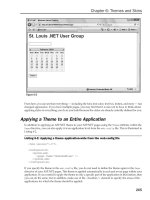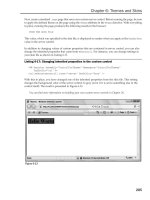Professional ASP.NET 3.5 in C# and Visual Basic Part 162 pps
Bạn đang xem bản rút gọn của tài liệu. Xem và tải ngay bản đầy đủ của tài liệu tại đây (559.3 KB, 10 trang )
Evjen bapp01.tex V1 - 01/28/2008 4:31pm Page 1576
Appendix A: Migrating Older ASP.NET Projects
The final step is a warning on how to handle the project if it is controlled by a source control system. If
it is, you want to ensure that the project or any of its components are checked out by someone. You also
want to ensure that the check-in capabilities are enabled. This warning is shown in Figure A-7.
Figure A-7
When you are ready to convert the project, click the Finish button. The actual conversion process could
take some time, so allow a few minutes for it. When the process is complete, you are offered a comple-
tion notification that also enables you to see the conversion log that was generated from the conversion
process (Figure A-8).
After the project is converted, you are presented with the conversion log, as shown in Figure A-9.
1576
Evjen bapp01.tex V1 - 01/28/2008 4:31pm Page 1577
Appendix A: Migrating Older ASP.NET Projects
Figure A-8
Figure A-9
1577
Evjen bapp01.tex V1 - 01/28/2008 4:31pm Page 1578
Appendix A: Migrating Older ASP.NET Projects
As you look over the project in the Solution Explorer, notice that some major changes have been made to
the project. Some of these changes include the following:
❑ All class files are removed from their folders and placed in the new
App_Code
folder. The folder
from which the class files were removed is left in place, even if the folder is empty after all the
classfilesareremoved.
❑ All the Visual Studio .NET 2002/2003 Web project files are deleted because Visual Studio 2008
does not use these any longer.
❑ The application’s DLL is deleted from the
Bin
folder.
❑ All the
.aspx
pages have had their
@Page
directives changed. An example from the
Default.aspx
page shows that the previousc
@Page
directive was constructed as:
<%@ Page Language="c#" CodeBehind="Default.aspx.cs" AutoEventWireup="false"
Inherits="ASPNET.StarterKit.IssueTracker._Default" %>
❑ After the conversion process, the @Page directive now appears as:
<%@ Page Language="c#" Inherits="ASPNET.StarterKit.IssueTracker._Default"
CodeFile="Default.aspx.cs" %>
❑ The code-behind classes for the
.aspx
pages are converted to partial classes (presented here in
C#). This is what the code behind for the
Default.aspx
page looked like before the conversion:
public class _Default : System.Web.UI.Page
{
// Code removed for clarity
}
❑ After the conversion process, the page class appears as shown here:
public partial class _Default : System.Web.UI.Page
{
// Code removed for clarity
}
For a full list of changes, look for a
ConversionReport.webinfo
file in the root of your solution. The
partial text from this example conversion is presented in Listing A-4. This conversion report can get quite
large, but pay attention to everything that was done to your project. In the following listing, some of the
four pages of this conversion report are shown.
Listing A-4: The ConversionReport.webinfo file
This report shows the steps taken to convert your Web application from
ASP.NET 1.1 to ASP.NET 2.0.
There may be some unresolved conversion issues you will need to manually fix.
For more information, please refer to />or search for the help topic "Converting from Visual Studio .NET 2002 or 2003".
1578
Evjen bapp01.tex V1 - 01/28/2008 4:31pm Page 1579
Appendix A: Migrating Older ASP.NET Projects
Conversion Started on project file IssueTrackerCSVS.csproj at April 17 2008,
16:48:39.
=========================ERRORS===================
=========================WARNINGS=================
Warning: This web project was converted as a file-based web application. If your
site contained any IIS meta-information, e.g. sub-folders marked as virtual
directories, it is recommended that you close this web site and re-open it
using the Open Web Site command and selecting the Local IIS tab.
=========================COMMENTS=================
Web.Config: Added ’xhtmlConformance’ attribute.
Web.Config: added a reference for assembly System.DirectoryServices.
Removed attribute AutoEventWireup from file Default.aspx.
Removed attribute CodeBehind from file Default.aspx.
Removed attribute AutoEventWireup from file DesktopDefault.aspx.
Removed attribute CodeBehind from file DesktopDefault.aspx.
Warning: Access level of ’Page_Load’ changed to ’protected’ in file
DesktopDefault.aspx.cs (Line 55).
Warning: Access level of ’Login’ changed to ’protected’ in file
DesktopDefault.aspx.cs (Line 62).
Warning: Access level of ’btnRegister_Click’ changed to ’protected’ in file
DesktopDefault.aspx.cs (Line 74).
Removed attribute Codebehind from file Global.asax.
Removed attribute AutoEventWireup from file LogOff.aspx.
Removed attribute CodeBehind from file LogOff.aspx.
Warning: Access level of ’Page_Load’ changed to ’protected’ in file
LogOff.aspx.cs (Line 49).
Removed attribute AutoEventWireup from file NoProjects.aspx.
Removed attribute CodeBehind from file NoProjects.aspx.
Removed attribute AutoEventWireup from file Register.aspx.
Removed attribute CodeBehind from file Register.aspx.
Warning: Access level of ’SaveUser’ changed to ’protected’ in file
Register.aspx.cs (Line 55).
Removed attribute AutoEventWireup from file administration
\
projects
\
addproject.aspx.
Removed attribute CodeBehind from file administration
\
projects
\
addproject.aspx.
Warning: Access level of ’Page_Load’ changed to ’protected’ in file
Removed file Bin
\
ASPNET.StarterKit.IssueTracker.dll.
Removed file IssueTrackerCSVS.csproj.
Removed file IssueTrackerCSVS.csproj.webinfo.
Project IssueTrackerCSVS.csproj has been converted successfully at April 17 2008,
16:50:12.
After the project is converted, you can build and run the application from Visual Studio 2008. The appli-
cation is now built and run on the ASP.NET 2.0 runtime.
Remember: Do not upgrade production solutions without testing your programs first in a staging envi-
ronment to ensure that your application is not affected by the changes between versions 1.0/1.1 and 2.0
or 3.5 of the .NET Framework.
1579
Evjen bapp01.tex V1 - 01/28/2008 4:31pm Page 1580
Appendix A: Migrating Older ASP.NET Projects
Migrating from ASP.NET 2.0 to 3.5
Visual Studio 2008 is the first version of the IDE that enables you to build applications at more than
one framework. For instance, Visual Studio .NET 2002 would only let you build 1.0 applications. If you
wanted to build .NET Framework 1.1 applications, then you were required to install and use Visual
Studio .NET 2003. At the same time, Visual Studio .NET 2003 would not enable you to build .NET
Framework 1.0 applications, meaning that if you were dealing with applications that made use of either
framework, then you were required to have both IDEs on your computer.
When you create a new project in Visual Studio 2008, you have the option of targeting the project at any
of the following frameworks:
❑ .NET Framework 2.0
❑ .NET Framework 3.0
❑ .NET Framework 3.5
Although you can open your .NET 2.0 applications and work with them directly in Visual Studio 2008,
when you first open an ASP.NET 2.0 application in the IDE, you will be prompted to update the applica-
tion to ASP.NET 3.5. The dialog box that you are presented with is shown in Figure A-10.
Figure A-10
Selecting Yes from this dialog box upgrades your ASP.NET 2.0 application to ASP.NET 3.5. You can also
right-click on the project in the Solution Explorer and select Property Pages from the provided menu.
This gives you a dialog box that enables you to change the target framework of the application. In this
case, you can see the default options on a Microsoft Vista computer (as shown in Figure A-11).
Although you can change the target framework as is illustrated in Figure A-11, you will find that it is
better to use Visual Studio 2008, as is shown in Figure A-10, to upgrade your ASP.NET applications.
Although ASP.NET 2.0 and ASP.NET 3.5 use the same .NET Framework 2.0 runtime, there are some
extra bolted-on additions available to ASP.NET 3.5 applications. The hooks into these extra capabilities
are established through changes made by Visual Studio 2008 to the web.config file in the upgrade process.
Some of the changes are detailed in the next few listings.
1580
Evjen bapp01.tex V1 - 01/28/2008 4:31pm Page 1581
Appendix A: Migrating Older ASP.NET Projects
Figure A-11
The first major change to the web.config file is presented here
in Listing A-5.
Listing A-5: Adding the .NET 3.5 language compilers
<system.codedom>
<compilers>
<compiler language="c#;cs;csharp" extension=".cs"
type="Microsoft.CSharp.CSharpCodeProvider,System, Version=2.0.0.0,
Culture=neutral, PublicKeyToken=b77a5c561934e089" compilerOptions="/w:1">
<providerOption name="CompilerVersion" value="v3.5"/>
</compiler>
<compiler language="vb;vbs;visualbasic;vbscript" extension=".vb"
type="Microsoft.VisualBasic.VBCodeProvider, System, Version=2.0.0.0,
Culture=neutral, PublicKeyToken=b77a5c561934e089"
compilerOptions="/optioninfer+">
<providerOption name="CompilerVersion" value="v3.5"/>
</compiler>
</compilers>
</system.codedom>
From this bit of the
web.config
, you can see that there are two new compilers provided in this configu-
ration code. Both the C# 3.5 and Visual Basic 3.5 compilers are targeted with ASP.NET 3.5.
1581
Evjen bapp01.tex V1 - 01/28/2008 4:31pm Page 1582
Appendix A: Migrating Older ASP.NET Projects
The next important change is in the <
compilation
> section of the
web.config
, as shown here
in Listing A-6.
Listing A-6: Adding new DLLs to ASP.NET with the 3.5 release
<compilation debug="true">
<assemblies>
<add assembly="System.Core, Version=2.0.0.0, Culture=neutral,
PublicKeyToken=B77A5C561934E089"/>
<add assembly="System.Web.Extensions, Version=2.0.0.0, Culture=neutral,
PublicKeyToken=31BF3856AD364E35"/>
</assemblies>
</compilation>
In ASP.NET 3.5, the
System.Core
and
System.Web.Extensions
DLLs are added and made available to
this new version of the framework.
In addition to these two major additions to the
web.config
, you will find large sections of other changes
that mainly deal with the new AJAX capabilities that ASP.NET 3.5 provides. If you are not using ASP.NET
AJAX in your applications, you can then delete these sections from the configuration file.
1582
Evjen bapp02.tex V2 - 01/28/2008 4:40pm Page 1583
ASP.NET Ultimate Tools
I’ve always believed that I’m only as good as my tools. I’ve spent years combing the Internet for
excellent tools to help me be a more effective developer. There are thousands of tools out there to
be sure, many overlapping in functionality with others. Some tools do one thing incredibly well
and others aim to be a Swiss Army Knife with dozens of small conveniences packed into their tiny
toolbars. Here is a short, exclusive list of some of the ASP.NET tools that I keep turning back to.
These are tools that I find myself using consistently while developing ASP.NET-based Web sites.
I recommend that you give them a try if they sound useful. Many are free; some are not. In my
opinion, each is worth at least a trial on your part, and many are worth your hard earned money as
they’ll save you precious time.
These tools can be easily searched for in your favorite search engine and found in the first page. For
those that are harder to find, I’ve included URLs. I also encourage you to check out my annually
updated Ultimate Tools List at
www.hanselman.com/tools
andyoumightalsoenjoymyweekly
podcast at
www.hanselminutes.com
as we often discover and share new tools for the developer
enthusiast.
Enjoy!
–Scott Hanselman
Debugging Made Easier
‘‘There has never been an unexpectedly short debugging period in the history of computers.’’
—StevenLevy
Evjen bapp02.tex V2 - 01/28/2008 4:40pm Page 1584
Appendix B: ASP.NET Ultimate Tools
Firebug
There are so many great things about this application one could write a book about it. Firebug is actually
a Firefox plug-in, so you’ll need to download and install Firefox to use it.
The screenshot below shows Firebug analyzing all the network traffic required to download my page.
This shows a very detailed graph of when each asset is downloaded and how long it took from first byte
to last byte as seen in Figure B-1.
Figure B-1
It has a wealth of interesting features that allow you to inspect HTML and deeply analyze your CSS
including visualization of some more complicated CSS techniques such as offsets, margins, borders, and
padding. Firebug also includes a powerful JavaScript debugger that will enable you to debug JavaScript
within Firefox. Even more interesting is its JavaScript profiler and a very detailed error handler that helps
you chase down even the most obscure bugs.
Finally, Firebug includes an interactive console feature like the Visual Studio Immediate window that lets
you execute JavaScript on-the-fly, as well as console debugging that enables classic ‘‘got here’’ debugging.
Firebug is indispensable for the Web developer and it’s highly recommended.
There is also Firebug Lite in the form of a JavaScript file. You can add it to the pages
in which you want a console debugger to work in Internet Explorer, Opera, or
Safari. This file will enable you to do ‘‘got here’’ debugging using the Firebug
JavaScript
console.log
method.
1584
Evjen bapp02.tex V2 - 01/28/2008 4:40pm Page 1585
Appendix B: ASP.NET Ultimate Tools
YSlow
YSlow is an add-on to an add-on. Brought to you by Yahoo!, YSlow extends Firebug and analyzes your
Web pages using Yahoo’s 13 rules for fast Web sites. In Figure B-2, you can see Yahoo’s YSlow analyzing
my blog.
Figure B-2
In some instances, I do well, but in others I receive a failing grade. For example, rule number one says
to make fewer HTTP requests. My site has too many external assets. Each one of these requires an HTTP
request, so I suspect I could speed up my site considerably with some refactoring.
Not every rule will apply to you exactly, but Yahoo! knows what they’re doing and it’s worth your time
to use this tool and consider your grades in each category. At the very least, you’ll gain insight into
how your application behaves. For example, Figure B-3 shows how many HTTP requests and bytes are
transmitted with an empty cache versus a primed one.
YSlow is free and is an excellent resource to help you get a clear understanding about how hard the
client’s browser must work in order to view your Web site.
1585









